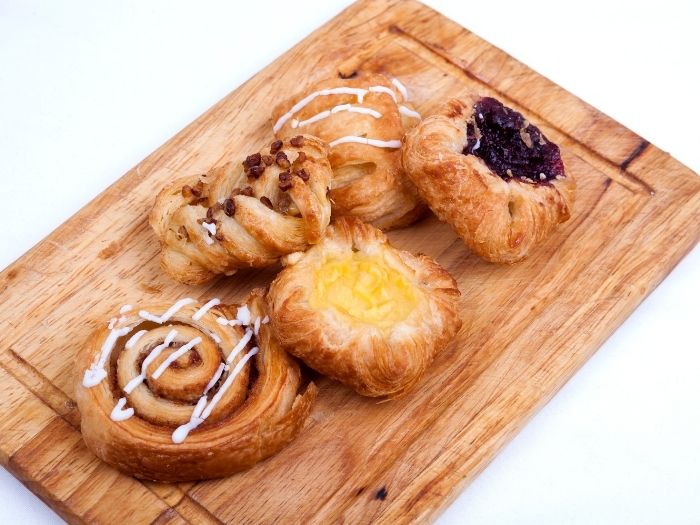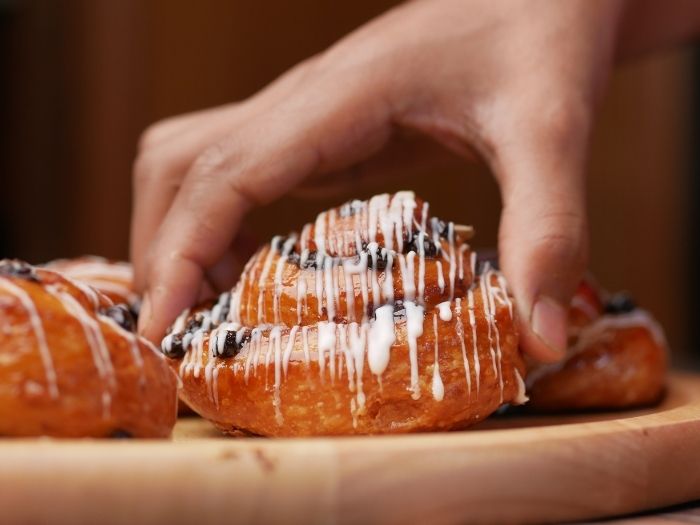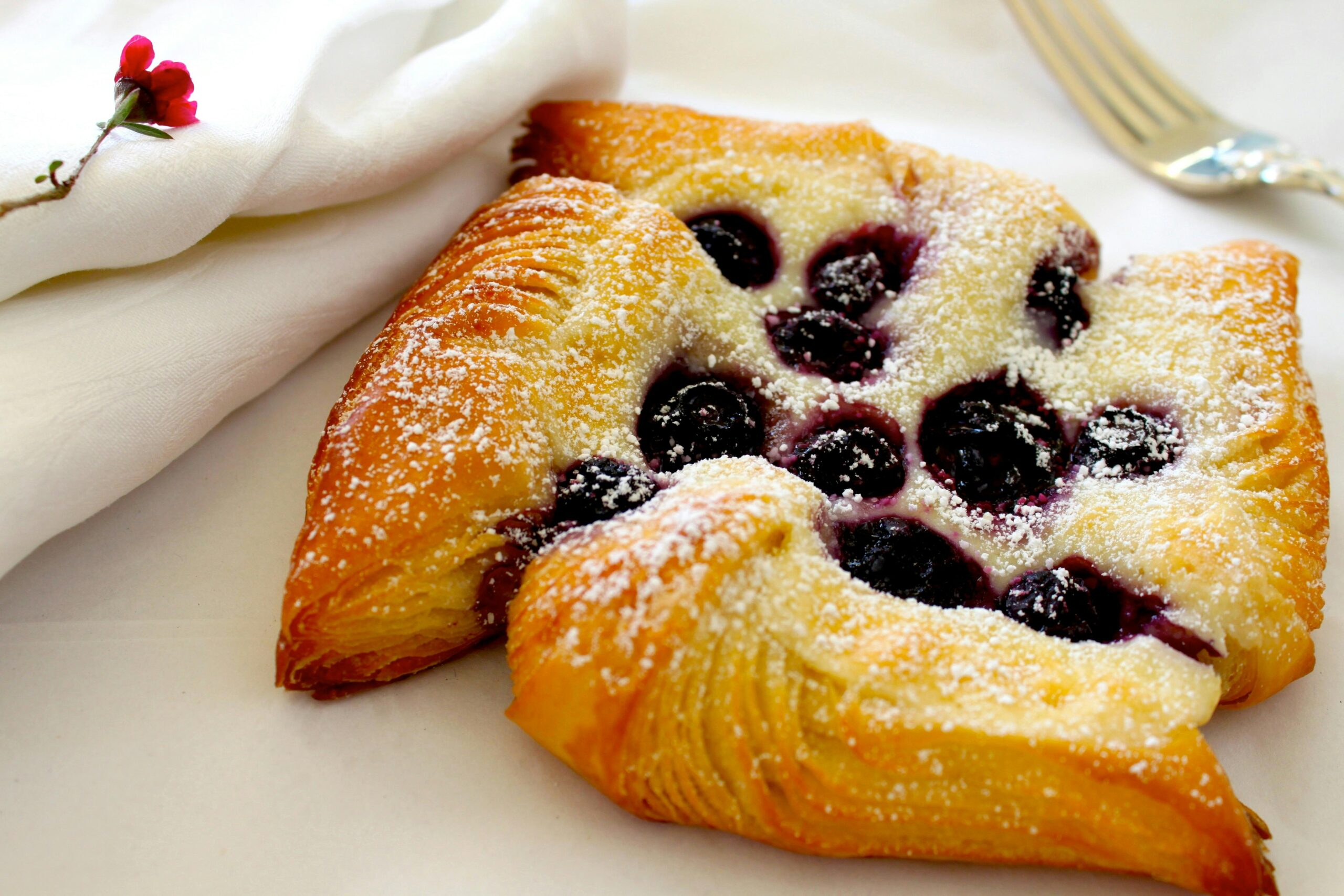Danish pastries aren’t just a treat—they’re a taste of Danish culture. Each flaky, buttery bite is packed with history, tradition, and a whole lot of deliciousness. And before you ask – in Denmark “Danish pastries” are not called Danish, but “Viennese Bread”, or “Vienna bread”!
In this article, we’ll dive into the story of Danish pastries, from their humble beginnings to their global fame. You’ll get to know the most popular types, their key ingredients, and the cultural meaning behind these sweet delights.
We’ll also explore what makes Danish pastries so special, where to find the best ones, and why they’re loved by so many. Whether you’re a pastry fan or just curious about Danish traditions, there’s something sweet waiting for you.
Are you ready to find out why Danish pastries are more than just dessert? Let’s dig into the rich layers of flavor, history, and tradition that make them irresistible!
What are Danish Pastries?
Danish pastries, or wienerbrød as it’s called in Denmark, are a favourite treat made from buttery, layered dough. In many ways they’re similar to croissants but a bit sweeter, and they are often filled with goodies like jam, custard, or cream cheese.
What makes Danish pastries special is their texture—crispy on the outside, soft and airy on the inside. The folding process creates those irresistible layers in every bite.
Pastries are however more than just a snack in Denmark – they’re a symbol of Danish baking craftsmanship, passed down through generations. Whether enjoyed with coffee as a daily treat or saved for special occasions, they’re a big part of Danish culture.
What are the Most Popular Types of Danish Pastries?
Danish pastries come in all sorts of shapes and flavours, making them hard to resist. One of the favourites is the spandauer, a round pastry filled with custard or fruit jam, often topped with sweet icing.
Another hit is the kanelsnegl (cinnamon snail), a soft, spiral pastry loaded with cinnamon and sugar.
For a crunchier option, try the frøsnapper, a twisted pastry sprinkled with poppy or sesame seeds for extra flavour and texture.
Other favourites include tebirkes, a poppy-seed covered bun, and the direktørsnegl (or “boss snail”), known for its rich, buttery layers.
Each pastry has its own unique twist, showing off the creativity of Danish baking, and they’re enjoyed all day long!
Typical Danish Pastries
Danish pastries are all about the right ingredients and careful prep. The dough, made from flour, butter, yeast, and milk, gives them that flaky, tender texture we love.
Many pastries are filled with tasty extras like fruit jam, custard, or cream cheese for a sweet kick. But what really makes them stand out is how the dough is folded over and over to create those light, crispy layers.
Every pastry is made with care, so each bite has the perfect mix of flavour and texture. Whether you’re biting into a fruity spandauer or a cinnamon-packed kanelsnegl, you’re in for a rich, flaky treat.
Typical Ingredients and Composition
The magic of these pastries comes from their simple but perfectly balanced ingredients. The dough is made with flour, yeast, milk, sugar, and plenty of butter, then folded over and over to create those signature flaky layers.
This technique, called laminating, gives them that light, airy texture that melts in your mouth. Fillings can vary, from custard to fruit jams, chocolate, or cream cheese, giving each pastry its own unique taste.
With their sweet, buttery richness, Danish pastries are hard to resist. The layering makes them stand out, offering a perfect mix of flavours and textures.
Since pastries has been a staple in Denmark for a century and a half, you can expect even the cheapest gas-station level pastries to be of a decent quality – and in many times also made with organic ingredients.
The History of Danish Pastries

Danish pastries have an interesting history that’s a blend of cultures. In the 1850s, a bakery strike in Denmark led to Austrian bakers stepping in to help. They brought with them the technique of making laminated dough—folding butter into dough multiple times to create layers.
Over time, Danish bakers adapted this method, adding their own local flavors and touches. This gave rise to the Danish pastries we love today.
By the early 20th century, Danish pastries had spread beyond Denmark, becoming popular in Europe and the U.S. What began as a solution during a labor strike evolved into a beloved Danish tradition. With fillings like custard, fruit, or nuts, these pastries became famous for their light, airy texture.
A blend of Austrian technique and Danish creativity made these pastries a true symbol of Danish baking.
The Evolution of Recipes Over Time
Danish pastry recipes have evolved by blending tradition with innovation. While the original Austrian recipes used simple laminated dough, Danish bakers began experimenting with new flavors and fillings over time. They added ingredients like custard, fruit preserves, and even savory options like cheese.
Today, modern twists continue to pop up, but the signature flaky layers remain at the heart of the pastry.
Traditions Around Danish Pastries
Danish pastries are a big part of Denmark’s culture. They’re more than just food—they represent connection, comfort, and joy in daily life.
From casual office breakfasts to weekend rituals, Danish pastries are everywhere. They’re part of both special occasions and everyday routines, showing how important these delicious treats are in Danish society.
Pastry for Breakfast in the Office on Fridays
In many Danish workplaces, Fridays are special because they mean pastries for breakfast. Colleagues gather around to enjoy freshly baked treats, from sweet wienerbrød to savory options. This is often accompanied by “Rundstykker” – small bread buns with different delicious textures and toppings, enjoyed with cold cuts.
This tradition is about more than just food—it brings people together, offering a moment to relax and celebrate the end of the workweek. Sharing pastries turns an ordinary Friday morning into something everyone looks forward to.
Wednesday Cinnamon Roll (They’re Bigger and Cheaper!)

Wednesdays in Denmark just get a lot better thanks to the “Wednesday” cinnamon roll. These treats are larger than the normal rolls, and you will find them at pretty much every baker and supermarket – at a large discount.
It’s a little tradition that adds sweetness to the day. People grab one for a break during their busy week, sharing the treat with friends or coworkers and enjoying a delicious pause.
Sunday Relaxation with a Newspaper and Wienerbrød
Sundays in Denmark are all about relaxing, and many Danes start their day with a wienerbrød and a newspaper. It’s a comforting ritual—savoring a flaky pastry while catching up on the news. This also mean that you should expect a pretty decent line at the baker during the weekends – much longer lines than you would typically expect – but that’s because it’s worth it!
This simple pleasure makes Sundays special, allowing people to slow down and enjoy the moment. A cozy setting, a delicious pastry, and some leisurely reading create the perfect way to unwind.
Different Types of Danish Pastries
Pastries come in all shapes and flavors. One of the most popular is the spandauer, a round pastry filled with custard or fruit jam with icing on top. Then there’s the kanelsnegl, or cinnamon snail, a spiral pastry filled with cinnamon and sugar.
If you like crunchier treats, try the frøsnapper—a twisted pastry sprinkled with seeds—or the tebirkes, a poppy-seed-covered bun.
Each pastry offers a unique taste, showcasing the creativity of Danish bakers. Whether you’re into sweet or savory, there’s a Danish pastry for everyone.
Famous Danish Pastries
Denmark is home to many iconic pastries. The spandauer, with its custard or jam filling and icing, is one of the most famous. There’s also the kanelsnegl (cinnamon snail) and the frøsnapper, a seed-topped twist.
Each pastry reflects Denmark’s baking creativity, and they’ve become famous for their delicious flavors and flaky textures.
Top 10 Most Famous Danish Pastries
- Wienerbrød: A long “bread” with marzipan, custard, chopped almonds and sugar.
- Kanelsnegl: A spiral cinnamon roll with a sweet filling.
- Spandauer: A pastry filled with custard or jam, topped with icing.
- Tebirkes: A flaky pastry covered in poppy seeds.
- Kringle: A large twisted pastry, usually filled with marzipan or fruit.
- Flødeboller: Chocolate-covered marshmallow treats on a biscuit base.
- Eclair: A cream-filled pastry popular in Denmark.
- Kardemommesnurre: A roll topped with sugar, spiced with cardamom
- Kanelstang: A long “bread” filled with more or less the same filling as the Kanelsnegl – but often with a different texture, and decorated with nuts.
- Boller: Soft, sweet rolls filled with chocolate or jam. You can also find these plain with no filling, which you can see danes enjoy with butter and cheese.
Regional and Seasonal Varieties
Danish pastries change with the seasons and regions. In the spring, you’ll find fillings like rhubarb or berries, while Christmas brings spiced options like cardamom and almond paste.
Each season brings fresh takes on these classic pastries, making them enjoyable year-round.
Danish Bakery Kringle
The kringle is a popular Danish pastry that has gained fame beyond Denmark. Shaped like an oval ring, it’s made with buttery dough and usually filled with nuts, cinnamon, or marzipan.
People often enjoy kringle during holidays and special occasions, as it blends sweet and savory flavors.
How Danish Pastries Stand Out
Danish pastries are unique for their dough preparation. Laminating—folding butter into dough—creates flaky layers. While croissants use a similar technique, Danish pastries are sweeter and often filled with custard, fruit, or cream cheese.
Their intricate shapes and the cultural significance behind them also set them apart.
Danish Pastries in the U.S.
Danish pastries became popular in the U.S. thanks to Danish immigrants in the early 20th century. Many settled in places like Wisconsin and shared their pastry-making skills. Soon, bakeries across the country were making Danish pastries, with the kringle becoming especially popular.
Today, Danish pastries are a common sight in American bakeries, with both traditional and modern versions enjoyed by all.
Top 10 Best Places to Buy Danish Pastries
If you’re looking for the best Danish pastries, check out these top bakeries in Denmark:
- Lagkagehuset: A favorite for both locals and tourists.
- Café Norden: A cozy spot for enjoying sweet treats.
- Bageriet Brød: Known for using organic ingredients.
- Bageri A. Bülow: A hidden gem in Aarhus.
- Søren Frank: Famous for its homemade pastries.
- Hjemmebageren: Celebrated for traditional recipes.
- Bageriet Ronn: A local favorite in Odense.
- Patisserie La Glace: A historic pastry shop in Copenhagen.
- Konditoriet Bageriet: A pastry lover’s haven in Vejle.
- Fællesskabet: Known for blending classic and modern styles.
Common Mistakes When Making or Buying Danish Pastries
When making these rolls of goodies at home, don’t rush the laminating process. Skipping or rushing through the folds can result in dense pastries. Also, give the dough enough time to rest between folds so it rises properly.
If you’re buying pastries, always go for freshly baked ones. Stale pastries lose their flaky texture and become chewy.
Lastly, choose high-quality fillings. Fresh ingredients make a big difference in flavor.
Conclusion
Danish pastries are more than just a treat—they’re a symbol of Danish craftsmanship. Their flaky layers and sweet or savory fillings showcase the creativity and skill of Danish bakers.
Whether you’re enjoying a classic spandauer or a nut-filled kringle, every bite offers a unique flavor experience. Danish bakeries, from big cities like Copenhagen to small towns, continue to keep these traditions alive.
The next time you bite into a Danish pastry, remember the artistry and care that goes into creating these delicious treats.
FAQs About Danish Pastries
Why are Danish pastries associated with Denmark?
Danish pastries became associated with Denmark when local bakers adapted Austrian techniques brought over in the 19th century. They perfected the lamination process and added unique Danish ingredients, making the pastries a cultural staple.
What is the most famous dessert in Denmark?
The spandauer is the most famous Danish pastry. It’s a round, flaky pastry filled with custard or fruit jam and topped with icing, commonly found in bakeries across Denmark.
What makes Danish pastries so flaky and light?
Danish pastries owe their light, flaky texture to the lamination process. This technique involves repeatedly folding butter into the dough, creating multiple thin layers. The layers puff up during baking, resulting in the delicate texture that Danish pastries are known for.
Where can you find the best Danish pastries in Copenhagen?
Copenhagen is home to several renowned bakeries, but Lagkagehuset and Andersen Bakery are top spots for Danish pastries. Both offer a wide variety of fresh pastries, including the classic kanelsnegl and spandauer, showcasing traditional recipes with a modern twist.
Where can I find Danish pastry recipes?
You can find Danish pastry recipes in various places. These places include cookbooks, online baking blogs, and recipe websites like King Arthur Flour. These sources provide detailed instructions for creating authentic Danish pastries at home, from the dough-making process to different filling options.
What is the best bakery in Copenhagen?
Lagkagehuset has many different locations, making them easy to find, and they always deliver great quality. With its wide range of Danish pastries, from buttery kringle to the iconic spandauer, this bakery is a favorite among locals and tourists alike.


